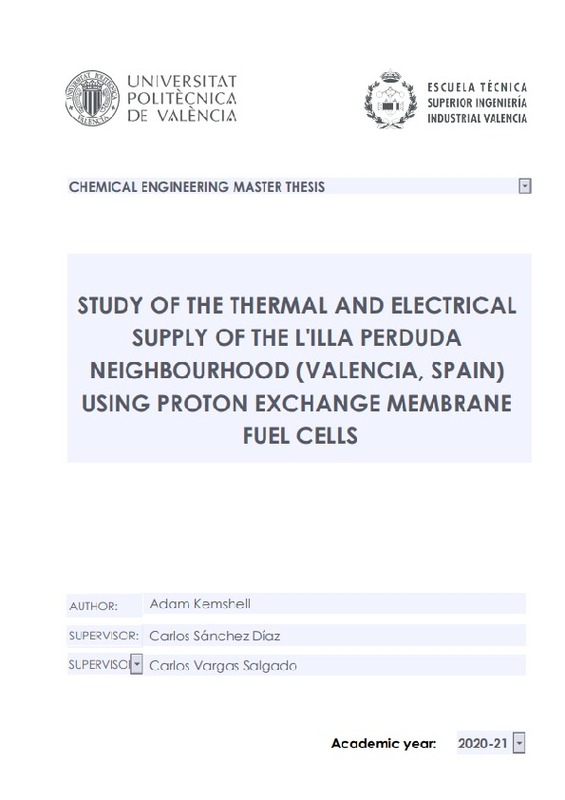|
Resumen:
|
[EN] Decentralised energy generation has been identified as a promising strategy towards powering a
sustainable future. It is well-established that centralised production at conventional power facilities is
inefficient ...[+]
[EN] Decentralised energy generation has been identified as a promising strategy towards powering a
sustainable future. It is well-established that centralised production at conventional power facilities is
inefficient and results in the significant release of greenhouse gas emissions. This thesis presents an
assessment of the techno-economic feasibility of using a Proton Exchange Membrane Fuel Cell
(PEMFC) energy system to accommodate the thermal and electrical demand of the L’illa Perduda
neighbourhood in Valencia, Spain. The PEMFC system, fed with natural gas, will generate both thermal
and electrical energy through the process of cogeneration, or combined heat and power (CHP), to
supplement existing energy supplies. Consumption data of the neighbourhood provided by the
Cátedra de Transición Energética Urbana, a collaboration between the Universitat Politècnica de
València and the Las Naves Foundation of the Valencia City Council, was analysed and an operating
model of the energy system was constructed on HOMER.
Peak thermal and electrical demands of the neighbourhood were determined to be 11.98 MWhth in
February and 3.37 MWhe in August, respectively. Based on demand variations throughout the year, to
inform the techno-economic viability of the project, a number of optimisations were conducted to
assess several energy system configurations. Based on ‘best estimate’ inputs, including a €2,000,000
/ MWe PEMFC capital cost and a €0.59 / m3 natural gas price, the existing grid-electric and boiler
infrastructure of the neighbourhood was deemed most economically viable. A net present cost (NPC)
of €47,637,932 (over 25 years) and a levelised cost of energy (LCOE) of €0.150 / kWh was determined
for the existing case. However, only a small increase in NPC (+4.2%) and LCOE (+8.0%) was observed
for the implementation of a 1 MWe grid-connected PEMFC-based CHP unit. In alignment with research
which suggests that fuel cells are only recently becoming competitive with conventional systems, this
result is comparable. Based on a sensitivity analysis of varying fuel cell and natural gas costs, natural
gas cost reductions were identified to significantly improve the economics, with the 1 MWe
configuration becoming economically feasible at a cost of €0.48 / m3
. In addition, fuel cell capital cost
reductions down to €1,400,000 were also determined to achieve this. On this basis, a full economic
appraisal should be carried out prior to project commissioning.
[-]
[ES] La generación distribuida de energía es una estrategia prometedora para impulsar un futuro
sostenible. La producción de energía centralizada en las instalaciones eléctricas convencionales es
ineficiente y provoca ...[+]
[ES] La generación distribuida de energía es una estrategia prometedora para impulsar un futuro
sostenible. La producción de energía centralizada en las instalaciones eléctricas convencionales es
ineficiente y provoca un aumento de las emisiones de gases de efecto invernadero. Este proyecto
presenta una evaluación técnico-económica de la viabilidad del uso de pilas de combustible de
membrana de intercambio de protones (PEMFC) para suministrar energía térmica y eléctrica al barrio
de L’illa Perduda en Valencia, España. El sistema PEMFC, alimentado con gas natural, generaría energía
tanto térmica como eléctrica mediante cogeneración (CHP), y complementaría a la red de suministro
local. Se analizaron los datos de consumo del barrio facilitados por la Cátedra de Transición Energética
Urbana, en colaboración con la Universitat Politècnica de València y la Fundación Las Naves del
Ayuntamiento de Valencia y se simuló un modelo de funcionamiento delsistema energético utilizando
el software HOMER.
Se determinó que las demandas térmicas y eléctricas máximas del vecindario fueron de 11,98 MWhth
en febrero y 3,37 MWhe en agosto, respectivamente. Sobre la base de las variaciones de la demanda
a lo largo del año, para informar la viabilidad técnico-económica del proyecto, se llevaron a cabo una
serie de optimizaciones para evaluar distintas configuraciones de sistemas de energía. En base a las
mejores estimaciones utilizadas como inputs, incluidos el coste de los sistemas PEMFC (2.000.000 € /
MWe), un precio del gas natural de 0,59 €/m3 y utilizando la red eléctrica existente como sistema de
back up, el sistema se considera económicamente viable. Se determinó un valor actual neto (VAN) de
47.637.932 € (durante 25 años) y un coste levelizado de la energía (LCOE) de 0,150 € / kWh para el
caso existente. Sin embargo, se observó un pequeño aumento en VAN (+ 4.2%) y LCOE (+ 8.0%) para
la implementación de una unidad de cogeneración de 1 MWe basada en PEMFC conectada a la red.
Los resultados obtenidos están en la misma línea de las investigaciones realizadas que sugieren que
las pilas de combustible sólo empiezan a ser competitivas en comparación con los sistemas
convencionales. En base al análisis de sensibilidad basado en diferentes costes de gas natural, se
identificaron reducciones de costes de gas natural para mejorar significativamente la economía, y la
configuración de 1 MWe permitiendo que el sistema sea económicamente viable a un coste de € 0,48
/ m3. Además, para lograrlo, también requiere una reducción de los costes de capital de las pilas de
combustible hasta € 1.400.000. En función de lo dicho, se debe realizar una evaluación económica
completa antes de la puesta en marcha del proyecto.
[-]
|







